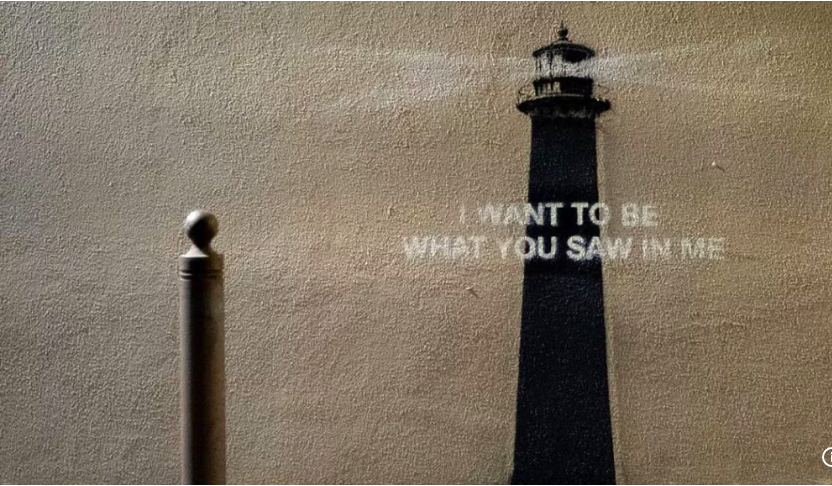“Banksy’s New Street Art Sparks Speculation in Marseille – Fans Decode Mysterious Lighthouse Message”

Banksy's Back – And This Time, Possibly in Marseille
Banksy has struck again — and fans are buzzing.
The elusive British street artist, known for provocative, mysterious, and socially reflective works, unveiled a new piece on Instagram on Thursday. The image shows a traffic bollard casting the shadow of a lighthouse, accompanied by the words: “I want to be what you saw in me.”
No caption. No location. Just a powerful image — and within ten hours, over 500,000 likes.
Almost immediately, the guessing game began. Street art sleuths and Geoguessers took to social media to try to pinpoint the location of the piece. Their best bet so far? Marseille, in the south of France. The texture of the pavement, the shape of the bollard, and the Mediterranean light have led many to this coastal city — one with a long tradition of radical art and multicultural vibrance. But as with anything Banksy-related, nothing is confirmed.
Decoding the Message
Unlike some of Banksy’s more explicitly satirical pieces — such as his 2023 “Beastly London” murals featuring rhinos, elephants, and other wildlife in absurdly urban situations — this new artwork leans into ambiguity. It’s not overtly political. There are no direct references to war, capitalism, or consumerism.
Instead, it whispers.
“I want to be what you saw in me.”
The phrase has sparked a flood of interpretations. Is it a meditation on identity and the way we are perceived by others? A quiet plea to be understood or even to live up to someone's vision of us? For some, it speaks of modern alienation — the loneliness of being unseen or misread. Others view it as more hopeful: the human desire to become better, inspired by the love or faith someone else once had in us.
Then there’s the visual itself: a mundane, unremarkable bollard throwing the long shadow of a lighthouse. It’s a classic Banksy move — transforming the ordinary into something extraordinary. A lighthouse is a symbol of guidance, warning, protection. It watches from afar, steady, luminous. It's what people search for when they're lost. Buy projecting this metaphor onto a simple object, Banksy invites us to rethink our environment, our identities, and our relationships.
Perhaps it's a commentary on the way unnoticed elements — like a bollard, or even a person — can carry within them something far more significant. A kind of potential. A metaphorical beam of light.
The Mystery of Location
Geoguessers, whose digital detective skills often rival actual investigative agencies, have zoomed in on clues within the image. From the type of bollard to the surrounding stonework and lighting, the consensus seems to be Marseille. France has hosted several Banksy pieces in the past, including a 2018 series around Paris highlighting the refugee crisis. Marseille, with its unique blend of working-class grit, artistic legacy, and political edge, fits the profile for a Banksy canvas.
If confirmed, this would mark a rare but significant return to continental Europe for the artist, whose recent focus has remained largely on UK soil — including the widely publicised “Beastly London” campaign and the December 2024 “Mother and Child,” a reinterpretation of the Madonna and Child motif with a modern twist.
A Legacy of Surprise
This latest piece arrives just months after Blink-182 frontman Mark Hoppus sold a Banksy original at auction for €5.2 million. The appetite for Banksy works remains ferocious. Yet despite the growing commercialisation around his name, Banksy continues to operate outside of conventional art world norms — posting anonymously, installing artworks guerrilla-style, and refusing to bow to interpretation.
His most famous stunt remains the 2018 “Girl with Balloon” incident, when the painting shredded itself moments after being sold at Sotheby’s. It was later renamed “Love is in the Bin” and sold again for a record £18.6 million in 2021 — roughly €27 million in today’s money.
Why It Resonates
Part of Banksy’s genius lies not just in the art itself, but in its timing, placement, and emotional resonance. This new piece taps into something universal — the desire to be understood, to live up to someone’s image of us, to be more than what we appear to be.
At a time when people often feel isolated, judged, or unseen, the notion of a quiet lighthouse — a beacon of hope and recognition — is deeply poignant. The fact that this “lighthouse” is born of a bollard, something easily overlooked, speaks volumes.
Banksy is reminding us, again, that meaning is not just in what we see — but in how we see it.
And perhaps, in how we see ourselves.
Conclusion
As speculation continues to swirl about the location and meaning of Banksy’s latest work, one thing is clear: the artist hasn’t lost the ability to captivate, challenge, and move his audience — all without uttering a word. Whether this bollard-turned-lighthouse stands on a quiet Marseille street or somewhere else entirely, its message resonates across borders. In a world overloaded with noise, Banksy offers a moment of reflection — an invitation to reconsider how we see ourselves, others, and the seemingly insignificant details of everyday life. Once again, the anonymous artist proves that even the simplest images can cast the longest shadows.
- Art
- Causes
- Crafts
- Dance
- Drinks
- Film
- Fitness
- Food
- Juegos
- Gardening
- Health
- Home
- Literature
- Music
- Networking
- Other
- Party
- Religion
- Shopping
- Sports
- Theater
- Wellness


